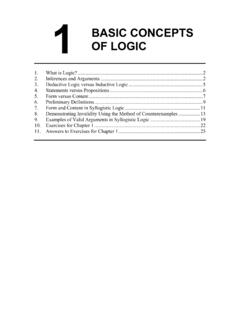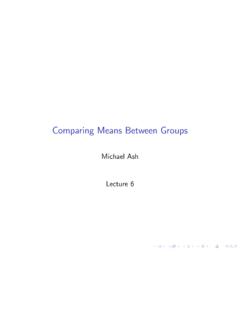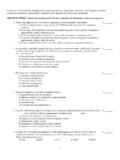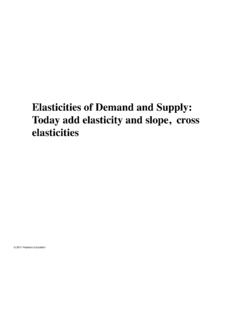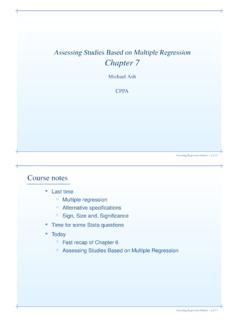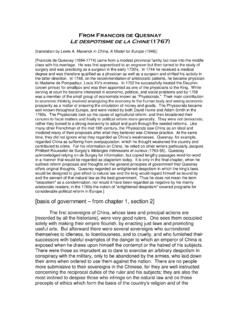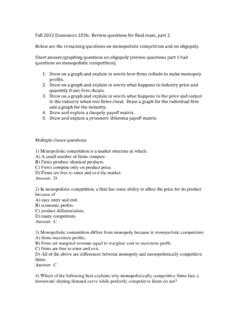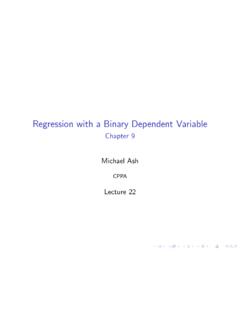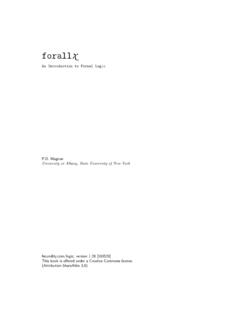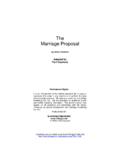Transcription of DERIVATIONS IN SENTENTIAL LOGIC - UMass
1 DERIVATIONS IN SENTENTIAL LOGIC 1. 2. The Basic 3. Argument Forms and Substitution 4. Simple Inference 5. Simple 6. The Official Inference 7. Inference Rules (Initial Set)..155 8. Inference Rules; Official 9. Show-Lines and Show-Rules; Direct 10. Examples of Direct 11. Conditional 12. Indirect Derivation (First Form)..169 13. Indirect Derivation (Second Form)..174 14. Showing Disjunctions Using Indirect 15. Further 16. Showing Conjunctions and 17. The Wedge-Out Strategy ..184 18. The Arrow-Out Strategy.
2 187 19. Summary of the System Rules for System 20. Pictorial Summary of the Rules of System 21. Pictorial Summary of 22. Exercises for Chapter 23. Answers to Exercises for Chapter 142 Hardegree, Symbolic LOGIC 1. INTRODUCTION In an earlier chapter, we studied a method of deciding whether an argument form of SENTENTIAL LOGIC is valid or invalid the method of truth-tables. Although this method is infallible (when applied correctly), in many instances it can be tedi-ous. For example, if an argument form involves five distinct atomic formulas (say, P, Q, R, S, T), then the associated truth table contains 32 rows.
3 Indeed, every addi-tional atomic formula doubles the size of the associated truth-table. This makes the truth-table method impractical in many cases, unless one has access to a computer. Even then, due to the "doubling" phenomenon, there are argument forms that even a very fast main-frame computer cannot solve, at least in a reasonable amount of time (say, less than 100 years!) Another shortcoming of the truth-table method is that it does not require much in the way of reasoning. It is simply a matter of mechanically following a simple set of directions.
4 Accordingly, this method does not afford much practice in reasoning, either formal or informal. For these two reasons, we now examine a second technique for demonstrating the validity of arguments the method of formal derivation, or simply derivation. Not only is this method less tedious and mechanical than the method of truth tables, it also provides practice in symbolic reasoning. Skill in symbolic reasoning can in turn be transferred to skill in practical rea-soning, although the transfer is not direct.
5 By analogy, skill in any game of strategy (say, chess) can be transferred indirectly to skill in general strategy (such as war, political or corporate). Of course, chess does not apply directly to any real strategic situation. Constructing a derivation requires more thinking than filling out truth-tables. Indeed, in some instances, constructing a derivation demands considerable ingenuity, just like a good combination in chess. Unfortunately, the method of formal derivation has its own shortcoming: un-like truth-tables, which can show both validity and invalidity, DERIVATIONS can only show validity.
6 If one succeeds in constructing a derivation, then one knows that the corresponding argument is valid. However, if one fails to construct a derivation, it does not mean that the argument is invalid. In the past, humans repeatedly failed to fly; this did not mean that flight was impossible. On the other hand, humans have repeatedly tried to construct perpetual motion machines, and they have failed. Sometimes failure is due to lack of cleverness; sometimes failure is due to the im-possibility of the task! Chapter 5: DERIVATIONS in SENTENTIAL LOGIC 143 2.
7 THE BASIC IDEA Underlying the method of formal DERIVATIONS is the following fundamental idea. Granting the validity of a few selected argument forms, we can demonstrate the validity of other argument forms. A simple illustration of this procedure might be useful. In an earlier chapter, we used the method of truth-tables to demonstrate the validity of numerous argu-ments. Among these, a few stand out for special mention. The first, and simplest one perhaps, is the following. (MP) P Q P Q This argument form is traditionally called modus ponens, which is short for modus ponendo ponens, which is a Latin expression meaning the mode of affirming by affirming.
8 It is so called because, in this mode of reasoning, one goes from an affirmative premise to an affirmative conclusion. It is easy to show that (MP) is a valid argument, using truth-tables. But we can use it to show other argument forms are also valid. Let us consider a simple example. (a1) P P Q Q R R We can, of course, use truth-tables to show that (a1) is valid. Since there are three atomic formulas, 8 cases must be considered. However, we can also convince our-selves that (a1) is valid by reasoning as follows.
9 Proof: Suppose the premises are all true. Then, in particular, the first two premises are both true. But if P and P Q are both true, then Q must be true. Why? Because Q follows from P and P Q by modus ponens. So now we know that the following formulas are all true: P, P Q, Q, Q R. This means that, in particular, both Q and Q R are true. But R follows from Q and Q R, by modus ponens, so R (the conclusion) must also be true. Thus, if the premises are all true, then so is the conclusion. In other words, the argument form is valid.
10 What we have done is show that (a1) is valid assuming that (MP) is valid. Another important classical argument form is the following. 144 Hardegree, Symbolic LOGIC (MT) P Q ~Q ~P This argument form is traditionally called modus tollens, which is short for modus tollendo tollens, which is a Latin expression meaning the mode of denying by denying. It is so called because, in this mode of reasoning, one goes from a negative premise to a negative conclusion. Granting (MT), we can show that the following argument form is also valid.
